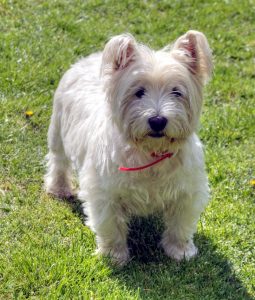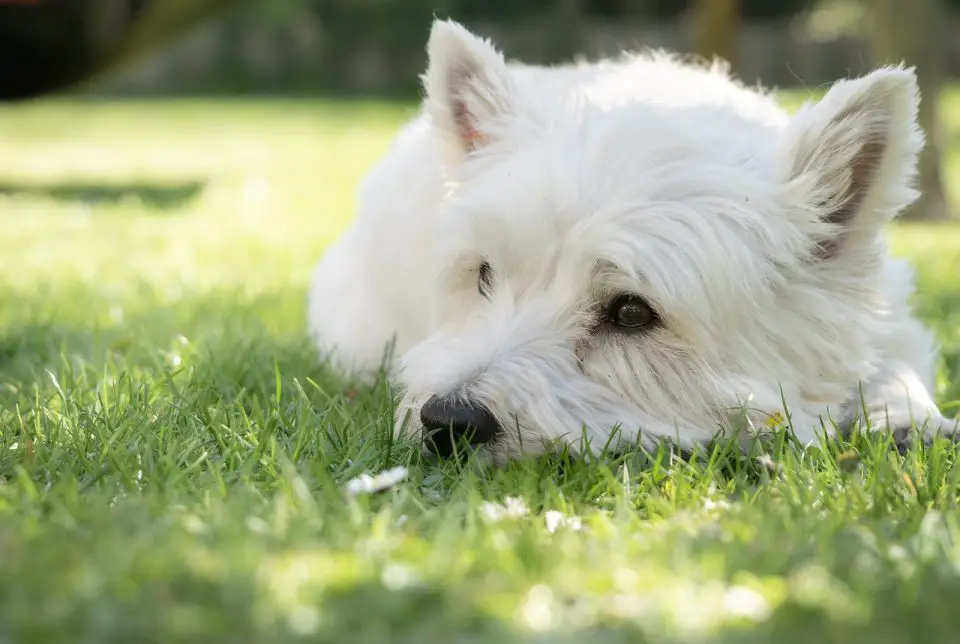Westies are smaller dogs with big personalities. Lively, friendly and typically happy dogs, these active and intelligent pooches will keep you entertained every day.
Their natural confidence shines through and will win the hearts of everyone they meet.
Also known by the longer version of their name, the West Highland White Terrier, these dogs were bred to be wonderful rodent hunters and many of the breed still show this keen eye for hunting prey to this day.
Fortunately, their hunting instinct can be turned to toys and play.
These fluffy companions make great buddies but with any furry pet, the issue of shedding often arises, especially with some of us humans suffering from allergies and aversions to hairy clothes and homes!
Almost any animal will suffer from some shedding issues and westies are no different but there is good news!
Westies are among the dogs that have little to no shedding issues. Keep reading for more information on westies and their shedding.
Do Westies Shed?
Do Westies shed? Yes, Westies do shed. However, It isn’t all bad news when it comes to westies shedding though! Although there is some shedding it is minimal and westies are considered a breed that only shed a little! Therefore, they fit nicely into the “non-shedding” dog breed category, due to how little they do shed.
This trait that means they don’t tend to shed comes with other issues though. Westie’s don’t go through the usual annual shedding and regrowth of their coats that many dog breeds contend with.
This doesn’t stop them needing to rid themselves of old and dead hair. As they don’t naturally shed themselves, regular trips to the dog groomers will be necessary to ensure a healthy coat that does its job to protect your dogs skin.
Short History of Westies
Westies come from a long line of Scottish terriers that are thought to have all originated from the same family tree with different breeds coming from different branches.
These smaller terriers were bred originally to be the solution to infestations for farmers and landowners alike.
The exact origins of the West Highland White Terrier are somewhat shrouded in mystery but the modern breed we know and love today came from an estate in Scotland called Poltalloch in the 1700’s.
It is on this estate, the Malcolm clan, like many of their Scottish forefathers, needed a small, hardy dog to help keep pest infestations down.
Hence, the westie was born and bred for over a hundred years on the estate for this very purpose.
It wasn’t until later in 1800s that the westie breed made its debut into dog shows in Scotland and became known as the West Highland White Terrier.
Named after the area in Scotland the breed originated from and their distinctive white coat.
What Is A Westies Coat Like?
 Aside from its white colour, a westies coat is made from a double layer of hair.
Aside from its white colour, a westies coat is made from a double layer of hair.
The underneath layer is a soft coating of fur like hair that is short, tight and close to the skin. The outer layer is made from longer and coarser hair. This outer layer is made of hair about two inches long that is usually straight.
This double layer of hair is what gives the westie its cuddly look and with its double layer of short, soft fur paired with a longer hair covering this dog it is as soft to pet as it is to look at.
Some westies love nothing more than to be a lap dog but don’t forget their independent, inquisitive natures means they may not always want to cuddle up next to you.
But don’t worry, they will always come back to for more affection when they have finished playing and chasing their toys.
Coats can vary from dog to dog and much will depend on your pet pooches breeding history, health and lifestyle.
All of these variations can vary a westies coat from thick and full hair to sparser and coarser hair but any dog groomer will be able to work with the coat your westie has and offer advice on how to take the best care of it.
How Much Do Westies Shed?
Whilst some shedding in all hairy mammals is normal, a westie is considered a breed of dog with little to no shedding and far less dander than many dog breeds.
This greatly reduces the time needed to spend cleaning homes, clothes and grooming your dog for hair shedding and can be good news for allergy sufferers too!
When Do Westies Shed the Most?
Many dogs have inherited the trait for their ancestors to shed their coats once or twice a year but with breeding, over a long period of time, this trait has disappeared from most westie dogs and they shed very little, no matter what the season is.
So, you may not suffer the spring hair storm that many dog owners struggle with as their dogs rid themselves of their winter coats but you will need to consider this when choosing a westie as your next companion.
They do require regular trips to the doggy groomers for help to shed old hair and encourage regrowth of new healthy hair.
If your westie is shedding or if their shedding habits have changed then it could be a sign that something is wrong. Then it’s time for a trip to the vets to see if there is an underlying problem that needs addressing.
If your pooch is perfectly healthy then the next step is the dog groomers for advice and a haircut. Any experienced groomer will be able to advise you on how to care for a shedding dog.
How To Combat A Westie Shedding
 Whilst you shouldn’t have too many shedding issues with a westie, if your West Highland White Terrier is on the hairier side then you can help with a regular grooming schedule.
Whilst you shouldn’t have too many shedding issues with a westie, if your West Highland White Terrier is on the hairier side then you can help with a regular grooming schedule.
You can brush your pet yourself to keep it looking neat and tidy and it’s hair tangle and dirt free and to get rid of any loose hairs.
Your westie shouldn’t shed enough to cause you a problem but regular grooming is an absolute must.
A professional groomer will be able to help you when it comes to stripping the dead hair so that your pet can grow a brand new and healthy coat.
This is important to take into consideration when selecting a westie as a pet. This manual grooming is a necessary part of keeping your dog healthy and happy.
Can I Reduce The Amount My Westies Shed?
The short answer is, no. A healthy westie won’t shed very much and it’s hard to reduce this any further.
There are things you can do to help keep your pups coat healthy between visits to the groomer.
By brushing and grooming regularly you will help keep tangles at bay which can be a problem with longer-haired dog breeds, especially when your dog has a westie nature and attitude.
This breed loves a good walk and will love exploring the countryside. To keep your dog neat, clean and tangle-free then you can brush them a couple of times a week with a pet mitt or grooming brush.
This should be enough to keep your pooch looking neat and tidy. If your pet has a particular penchant for mischief and getting into muddy puddles and messes then even more regular brushing or even daily brushing may be needed.
Equipment To Help With Westie Shedding
A westie may not shed very much but with their double layer of hair and longer coats, they do need regular grooming and maintenance to keep their coats healthy.
A slicker brush is a great all-round grooming tool. It has rows of bristles on either a flat or curved head that is great for removing loose hair or for detangling a messy coat.
A Pin brush works fantastically on a longer haired dog and a westie may benefit from grooming using this tool. This brush is similar to a slicker brush but its bristles are tipped with plastic or rubber.
An undercoat rake is perfect for combing out that dense undercoat a westie has. It is similar to a pin brush but with fewer bristles.
A grooming mitt is a great tool for a quick everyday groom. You pop the glove on your hand and pet your dog in soft, smooth motions and it’s rubble tips help detangle and remove any trapped dirt and help remove daily tangles that any long-haired pooch can suffer with.
Are Westies Considered Hypoallergenic
No dog can ever be truly considered hypoallergenic. It is a nature of pet ownership that some mess, hair shedding and dander is to be expected which for those of us who suffer from allergies can make dog ownership difficult.
However, as dogs go, the westie is considered one of the more friendly to allergies and asthma dogs you can choose.
There is no guarantee that any allergy sufferer won’t have a problem still but if you are looking to reduce the risk of hair shedding then the west highland terrier is the perfect choice to consider.
Do Some Westies Shed More Than Others?

As with all dogs, no matter the breed, there will be some differences from dog to dog. Your dog’s characteristics and personality will be unique to your pet and this is true for hair shedding too.
The overall dog breed is considered one with none to minimal shedding but any variation in breeding through its ancestry or a change in your dogs characteristics can mean that it doesn’t completely match it’s breeding standard and may have slightly different shedding habits than the average westie.
Health Reasons For Increased Shedding In Westies
As with any breed of dog, the westie can have some health issues. It is considered a generally healthy breed but can have some issues including, cardiac disease and patellar luxation.
If your westie has started to shed then it may need a trip to the vet to see if there are any medical problems that need attending to.
There are a few things that could result in hair shedding;
Nutrition – A change in your dog’s diet can have an effect on their body and they may even develop an allergy.
Ensure your westie is fed appropriate food bought from reputable pet shops or pet food outlets will help ensure they have all the vitamins they need.
Allergies – Any animal can develop allergies and skin irritation is a common side effect.
This can lead to hair loss so make sure you have checked any medication your pup may be on for side effects and talk to the vet if these become a problem.
Other allergens your pet could be reacting to include shampoos, cleaning products and food.
Stress – westies can feel stress in similar ways that us humans can. Emotional difficulties when things are changing, such as a house move or a change in the household can induce stress.
Separation anxiety is a big problem for dogs that are left alone for long periods of time and can lead to them suffering with stress.
One of the effects that stress can have on your westie is hair loss and skin issues. The vet can offer you advice if you and your pooch are having problems.
Parasites and Pests – regular grooming and appropriate flea treatments should keep this issue at bay and avoid any extra skin issues.
Final Thoughts: Do Westies Shed?
 As furry companions go a westie is a lovable, cuddly, happy, go lucky pet with an energy and attitude that brightens up any family home.
As furry companions go a westie is a lovable, cuddly, happy, go lucky pet with an energy and attitude that brightens up any family home.
They love to play and chase and are sociable creatures that will find a place deep in your heart.
These pets require a little maintenance and care with grooming but this is far outweighed by their nature and the fact that they don’t shed, or if they do it is only a small amount!
Thank you for reading do Westies shed. Hope you have a great day!
